A nome (/noʊm/,[1] from Ancient Greek: νομός, nomós, "district") was a territorial division in ancient Egypt.[2]
Each nome was ruled by a nomarch (Ancient Egyptian: ḥrj tp ꜥꜣ, "Great Chief").[3] The number of nomes changed through the various periods of the history of ancient Egypt.[4]
Etymology
The term nome comes from Ancient Greek νομός, nomós, meaning "district"; the Ancient Egyptian term was sepat or spAt.[5] Today's use of the Ancient Greek rather than the Ancient Egyptian term came about during the Ptolemaic period, when the use of Greek was widespread in Egypt.[6] The availability of Greek records on Egypt influenced the adoption of Greek terms by later historians.
History
Dynastic Egypt
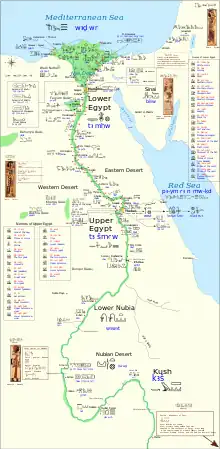
The division of ancient Egypt into nomes can be traced back to prehistoric Egypt (before 3100 BC). These nomes originally existed as autonomous city-states, but later began to unify. According to ancient tradition, the ruler Menes completed the final unification.[7]
Not only did the division into nomes remain in place for more than three millennia, the areas of the individual nomes and their ordering remained remarkably stable. Some, like Xois in the Nile Delta or Khent in Upper Egypt, were first mentioned on the Palermo Stone, which was inscribed in the Fifth Dynasty. The names of a few, like the nome of Bubastis, appeared no earlier than the New Kingdom. Under the system that prevailed for most of pharaonic Egypt's history, the country was divided into 42 nomes.
Lower Egypt nomes

Lower Egypt (Egyptian: "Ā-meḥty"), from the Old Kingdom capital Memphis to the Mediterranean Sea, comprised 20 nomes. The first was based around Memphis, Saqqara, and Giza, in the area occupied by modern-day Cairo. The nomes were numbered in a more or less orderly fashion south to north through the Nile Delta, first covering the territory on the west before continuing with the higher numbers to the east. Thus, Alexandria was in the Third Nome; Bubastis was in the Eighteenth.
- White Walls Nome
- Travellers land
- Cattle land
- Southern shield land
- Northern shield land
- Mountain bull land
- West harpoon land
- East harpoon land
- Andjety god land
- Black bull land
- Heseb bull land
- Calf and Cow land
- Prospering Sceptre land
- Eastmost land
- Ibis-Tehut land
- Fish land
- The throne land
- Prince of the South land
- Prince of the North land
- Sopdu-Plumed Falcon land
Upper Egypt nomes


Upper Egypt was divided into 22 nomes. The first of these was centered on Elephantine close to Egypt's border with Nubia at the First Cataract – the area of modern-day Aswan. From there the numbering progressed downriver in an orderly fashion along the narrow fertile strip of land that was the Nile valley. Waset (ancient Thebes or contemporary Luxor) was in the Fourth Nome, Amarna in the Fourteenth, and Meidum in the Twenty-first.
- Bows land
- Throne of Horus land
- Shrine land
- Sceptre land
- The two falcons land
- The crocodile land
- Sistrum land
- The Great land
- Min-God land
- Cobra land
- Sha-Set animal land
- Viper mountain land
- Upper Sycamore and Viper land
- Lower Sycamore and Viper land
- Hares land
- Oryx Nome
- Anubis land
- Set land
- Two Sceptres land
- Southern Sycamore land
- Northern Sycamore land
- Knife land
Ptolemaic Egypt
Some nomes were added or renamed during the Graeco-Roman occupation of Egypt.[8] For example, the Ptolemies renamed the Crocodilopolitan nome to Arsinoe. Hadrian created a new nome, Antinoopolites, for which Antinoöpolis was the capital.
Roman Egypt
The nomes survived into Roman times. Under Roman rule, individual nomes minted their own coinage, the so-called "nome coins", which still reflect individual local associations and traditions. The nomes of Egypt retained their primary importance as administrative units until the fundamental rearrangement of the bureaucracy during the reigns of Diocletian and Constantine the Great.
From AD 307/8, their place was taken by smaller units called pagi. Eventually powerful local officials arose who were called pagarchs, through whom all patronage flowed. The pagarch's essential role was as an organizer of tax-collection. Later the pagarch assumed some military functions as well. The pagarchs were often wealthy landowners who reigned over the pagi from which they originated.
Nomarch
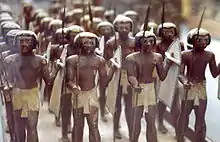
For most of the history, each nome was headed by a nomarch. The position of the nomarch was at times hereditary, while at others they were appointed by the pharaoh. Generally, when the national government was stronger, nomarchs were the king's appointed governors. When the central government was weaker, however—such as during foreign invasions or civil wars—individual nomes would assert themselves and establish hereditary lines of succession.[4] Conflicts among these different hereditary nomarchies were common, most notably during the First Intermediate Period, a time that saw a breakdown in central authority lasting from the 7th–11th Dynasties which ended when one of the local rulers became strong enough to again assert control over the entire country as pharaoh.
List of nomes
The nomes (Ancient Egyptian: spꜣt, Coptic: ⲡⲑⲱϣ) are listed in separate tables for "Isti" - "the two Egypts" (Upper and Lower Egypt).
Note:
- older or other variants of the name in square brackets '[ ]';
- names vary from different time or era, or even titles, most epithets, honorific titles with a slash '/';
- Greek-Egypto derived names from the original Egyptian in parentheses '()'
Lower Egypt
| Number | Nome Standard (Symbol on top of head of man or woman) | Ancient Egyptian
Nome Name |
Ancient Greek and Coptic Nome Name | Capital | Modern name of capital site | Translation | God | |||
|---|---|---|---|---|---|---|---|---|---|---|
| Known | Variants | Greek | Coptic | |||||||
| 1 |  |
Inebu-hedj | 𓈠 Inebu-hedj | Μεμφίτης
Memphites |
ⲙⲛⲫⲉ/ ⲉⲕⲉⲡϯⲁ | Ineb-Ḥedjet [ 𓏠𓈖𓄤𓆑𓂋𓉴𓊖 Men-nefer/ Menfe] (Memphis) | Mit Rahina | White Walls | Ptah | |
| 2 |  Khensu |
Khepesh | 𓈡 (Khensu) | Λητοπολίτης
Letopolites |
ⲃⲟⲩϣⲏⲙ | 𓐍𓋉𓅓𓊖 Khem [Sekhem/ Iry] (Letopolis) | Ausim | Cow's thigh | Horus | |
| 3 |  Iment (Ament) |
Imentet/ Amentet | 𓈢 Iment (Ament) | Γυναικοπολίτης
Gynaikopolites |
I-am/ Imu (Apis) | Kom El Hisn | West | Hathor | ||
| 4 | Nit Resu | 𓈣 (Sapi-Res) | Προσωπίτης
Prosopites |
ⲡϣⲁϯ | Niciu | Zawyet el-Razin | ||||
| 4 (21) |  Sapi-Res |
Nit Resu | 𓈣 (Sapi-Res) | Φθεμφουθ
Phthemphouth |
Ptkheka | Tanta | Southern shield | Sobek, Isis, Amun | ||
| 5 |   |
 Sap-Meh |
Nit Meḥtet, Nit Meḥetet | 𓈤/𓈥 (Sap-Meh) | Σαίτης
Saites |
ⲥⲁⲓ | 𓊃𓅭𓄿𓅱𓊖 Sau/ Zau (Sais) | Sa El Hagar | Northern shield | Neith |
| 6 |  Khaset |
Khasu'u/ Khasu'wu | 𓈦 (Khaset) | Ξοίτης
Xoites |
ⲥϧⲱⲟⲩ | 𓆼𓋴𓅱𓅱𓏏𓊖 Khasu (Xois) | Sakha | Mountain bull | Amun-Ra | |
| 7 |  A-ment |
Ḥui-ges Imenti/ Ḥui-ges Amenti | 𓈧 (A-ment) | Μενελαίτης
Menelaites |
𓂧𓏇𓇌𓊖𓏌𓅃𓏤 (Hermopolis Parva, Metelis) | Damanhur | West harpoon | Hu | ||
| 8 |  Nefer-Iabti |
Ḥui-ges Iabti/ Ḥui-ges Aabti | 𓈨 Nefer-Iabti (A-bt) | Ἡροοπολίτης
Heroopolites |
Thek/ Tjeku / Iset-Tem [= 𓉐𓏤𓏏𓍃𓅓𓏏𓊖 Per-Atum]/ Ān (Heroonpolis, Pithom) | Tell al-Maskhuta | East harpoon | Atum | ||
| 9 | 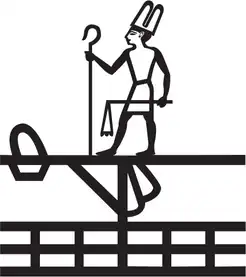 Ati |
‘Andjeti/ ‘Anedjti | 𓈩 (Ati) | Βουσιρίτης
Bousirites |
ⲡⲁⲛⲁⲩ | 𓉐𓏤𓊨𓁹𓎟𓊽𓂧𓅱𓊖 Djed/ Djedu [Iti] (Busiris) | Abu Sir Bara | Andjeti | Osiris | |
| 10 |  Ka-Khem |
Kem-Ur/ Kem-Wer | 𓈪 Ka-Ka'm (Ka-khem) | Ἀθριβίτης
Athribites |
ⲁⲑⲣⲏⲃⲓ | 𓉗𓏏𓉐𓇾𓁷𓄣𓊖 Hut-hery-ib (Athribis) | Banha (Tell Atrib) | Black bull | Horus | |
| 11 |  Ka-Heseb |
Ḥesbu/ Ḥesebu | 𓈫 (Ka-heseb) | Λεοντοπολίτης
Leontopolites |
ⲛⲁⲑⲱ | Taremu/ Ikhenu (Leontopolis) | Tell el-Muqdam | Heseb bull | Isis | |
| 12 |  Tjeb-Ka |
Tjeb-Netjer | 𓈬 (Theb-ka) | Σεβεννύτης
Sebennytes |
ϫⲉⲙⲛⲟⲩϯ | 𓊹𓍿𓃀𓊖 Tjebnutjer (Sebennytos) | Samanud | Calf and Cow | Anhur | |
| 13 | 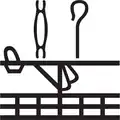 Heq-At |
Ḥeka-Redj | 𓈭 (Heq-At) | Ἡλιοπολίτης
Heliopolites |
ⲱⲛ | In (Iunu)/ In-meḥ/ Iset-Tem/ Igert, Igertet, Iqert, Iugertet (Heliopolis) | Materiya (suburb of Cairo) | Prospering Sceptre | Ra | |
| 14 |  Khent-Abt |
Khenti-Iabti/ Khenti-Aabti | 𓈮 (Khent-abt) | Σεθρωίτης
Sethroites |
Tjaru/ Dj‘anet (Sile, Tanis) | Tell Abu Sefa | Eastmost/ Foremost of the East | Horus | ||
| 15 |  Djehuti |
Djeḥuti | 𓈯 (Tehut) | Μενδήσιος
Mendesios |
ⲛⲓⲙⲉϣϣⲱⲧ | Ba'h / Weprehwy (Hermopolis Parva) | Baqliya | Djehuti (Thoth)/ Ibis | Thoth | |
| 16 |  Kha |
Ḥat Meḥit | 𓈰 (Kha) | Μενδήσιος
Mendesios |
ⲛⲓⲙⲉϣϣⲱⲧ | Djedet/ Ā'atjaba (Mendes) | Tell El Rubˁ | Fish/ Foremost of the Fish | Banebdjedet and Hatmehyt | |
| 17 |  Sema-Beḥut |
 Sema-Beḥut |
Beḥdet/ Beḥedet | 𓈱/𓈲 Sma-Beḥut (Sema-Beḥut) | Διοπολίτης Κάτω
Diospolites Kato |
ⲡⲟⲩⲛⲉⲙⲟⲩ | Semabehdet (Diospolis Inferior) | Tel El Balamun | The Throne/ Throne of Horus of Behdet | Amun-Ra |
| 18 |  Im-Khent |
Imty Khenti/ Amty Khenti | 𓈳 Im-Khent (Am-Khent) | Βουβαστίτης
Boubastites |
ⲡⲟⲩⲃⲁⲥϯ | Per-Bastet (Bubastis) | Tell Bastah (near Zagazig) | Prince of the South | Bastet | |
| 19 |  Im-Peḥ |
Imty Peḥu/ Amty Peḥu | 𓈴 Im-Peḥ (Am-Peḥu) | Τανίτης
Tanites |
ϫⲁⲛⲏ | Dja'net (Leontopolis Tanis) | Tell Nebesha or San El Hagar | Prince of the North | Uatchet | |
| 20 |  Sep-d |
Sepdju/ Sepedju | 𓈵 Sep-d (Sopdu) | Ἀραβία
Arabia |
ϯⲁⲣⲁⲃⲓⲁ | Per-Sopdu | Saft El Hinna | Plumed Falcon/ Sepdju | Sopdet | |
Upper Egypt
| Number | Nome Standard
(Symbol on top of head of man or woman) |
Ancient Egyptian
Nome Name |
Capital | Modern Capital | Translation | God | ||
|---|---|---|---|---|---|---|---|---|
| Known | Variants | |||||||
| 1 |  Ta-Seti |
Ta-Seti | 𓈶 𓈶(Ta-Seti) | 𓍋𓃀𓃰𓅱𓎶𓈊 Abu / Yeb [Yb] (Elephantine) | Sunnu/ Irp-Ḥesp (Aswan) | Land of the bow | Khnum | |
| 2 |  Wetjes-Her |
Wetjes-Ḥer | 𓈷 (Wetjes-Hor) | 𓌥𓃀𓊖 Djeba (Apollonopolis Magna) | Ineb/ Iset-Unep/ Iset-en-Rā/ Iset-Neterui/ Iset-Ḥeq/ Iset-Khnem-Iten/ Iset-Sekhen-en-Ḥeru-Iakhuti/ Iset-Shu/ Isebt/ Ā'ay-t-en-Beḥud/ Ā'a-t-enty-Ā'ap (Edfu) | Throne of Horus | Horus-Behdety | |
| 3 |  Nekhen |
Nekhen | 𓈸 (Nekhen) | Nekhen (Hierakonpolis) | Elkab | Shrine | Nekhebet | |
| 4 |  Uas (Uaset/ Waset) |
Waset/ Uaset | 𓈹 Uas (Uaset/ Waset) | Niwt-rst / Waset [Ir-t Rā/ Iset-Sekhenu-en-Ākhemu/ Ānkh] (Thebes) | Luxor | Sceptre | Amun-Ra | |
| 5 | Netjerui | 𓈺 (Herui) | 𓎤𓃀𓅂𓊖 Gebtu/ Iter-Shemā (Coptos) | Qift | The two falcons | Min | ||
| 6 |  Iqer |
 Iqer |
Meseḥ/ Mes-ḥ | 𓈻 (Iqer) | In/ In-en-P'teḥ/ In-en-Nut/ In-Ta-Neferet/ Iset-Au-Ib/ Iset-Au-Ib-enti-Neteru-Nebu/ Iset-Iabes-Ḥet-Ḥer/ Iset-Iset-em-Khet-Ḥā-s/ Iset-urt-en-Ḥem-Ḥeru-Iakhuty/ Iset-Per-Ḥet-Ḥer-Kher-Menu/ Iset-Per-Seshem-en-Ḥet-Ḥer-Ureth-Nebt-Tawy-Im/ Iset-Peṣis-Ta/ Iset-Pesh-Nebty/ Iset-M'as-Menu-ent-Ḥet-Ḥer-Imṣ/ Iset-M'as-Snef-sa/ Iset-Meskhenet-en-Iset/ Iset-enth-Mut-Ḥeru/ Iset-ent-Rā-Ḥeru-Iakhuti/ Iset-enth-Ḥemt-Nesu/ Iset-ent-Ḥet-Ḥer-Nebt-In/ Iset-Hy/ Isut-Ḥeru/ Iset-Ḥeḥ/ Iset-Khadbut-em-Āq-en-Netert-Ten/ Iset-Sekhem-Ānkh-en-Neter/ Iset-Shātu-Menu-en-Neb-In-Im-ṣ/ Iset-Shepset-Ḥent-Neterit/ Iset-Qen-Ḥeru-em-Baḥ-Mutef-Iset/ Iset-Tekh/ Iset-Tekh-ent-Ḥeru-Iakhuti/ Iset-Djeser/ Ān-Ḥer/ Iunet (Tantere/ Tentyra/ Dendera) | In/ In-en-P'teḥ/ In-en-Nut/ In-Ta-Neferet/ Iset-Au-Ib/ Iset-Au-Ib-enti-Neteru-Nebu/ Iset-Iabes-Ḥet-Ḥer/ Iset-Iset-em-Khet-Ḥā-s/ Iset-urt-en-Ḥem-Ḥeru-Iakhuty/ Iset-Per-Ḥet-Ḥer-Kher-Menu/ Iset-Per-Seshem-en-Ḥet-Ḥer-Ureth-Nebt-Tawy-Im/ Iset-Peṣis-Ta/ Iset-Pesh-Nebty/ Iset-M'as-Menu-ent-Ḥet-Ḥer-Imṣ/ Iset-M'as-Snef-sa/ Iset-Meskhenet-en-Iset/ Iset-enth-Mut-Ḥeru/ Iset-ent-Rā-Ḥeru-Iakhuti/ Iset-enth-Ḥemt-Nesu/ Iset-ent-Ḥet-Ḥer-Nebt-In/ Iset-en-Sek-Djet/ Iset-Hy/ Isut-Ḥeru/ Iset-Ḥeḥ/ Iset-Khadbut-em-Āq-en-Netert-Ten/ Iset-Sekhem-Ānkh-en-Neter/ Iset-Shātu-Menu-en-Neb-In-Im-ṣ/ Iset-Shepset-Ḥent-Neterit/ Iset-Qen-Ḥeru-em-Baḥ-Mutef-Iset/ Iset-Tekh/ Iset-Tekh-ent-Ḥeru-Iakhuti/ Iset-Djeser/ Ān-Ḥer/ Iunet (Tantere/ Tentyra/ Dendera) | The crocodile | Hathor |
| 7 |  Seshesh |
Bat | 𓈼 (Seshesh) | Seshesh/ Pa-Khen-Iment/ Uas-Meḥ (Diospolis Parva) | Hu | Sistrum | Hathor | |
| 8 |  Ta-wer |
Ta-Wer/ Ta-Ur | 𓈽 Ta-wer | Thinis | Great land | Anhur | ||
| 9 |  Min |
Menu/ Minu | 𓈾 (Min) | Ip/ Ipi/ Ipu/ Apu/ [later: Khen-Min, perhaps another name for "Khemenu"]/ Ārty-Ḥeru (Panopolis) | Akhmim | Min | Min | |
| 10 | 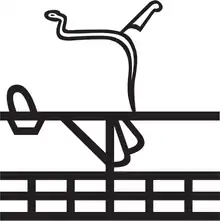 Uadj (Wadjet) |
 Uadj (Wadjet) |
Wadjyt/ Uadjyt | 𓈿/𓉀 Uadj (Wadjet) | Djew-qa / Tjebu (Antaeopolis) | Qaw El Kebir | Cobra | Hathor |
| 11 |  Set |
 Set |
Sha | 𓉁/𓉂 (Set) | Shashotep (Hypselis) | Shutb | The creature associated with Set | Khnum |
| 12 |  Ta-wer |
Dju-fet | 𓉃 (Tu-ph) | Pr nmty (Hieracon) | al Atawla | Viper mountain | Horus | |
| 13 |  Ta-wer |
Nedjfet Khentet/ Nedjefet Khentet | 𓉄 (Atef-Khent) | Zawty (z3wj-tj, Lycopolis) | Asyut | Upper Sycamore and Viper | Apuat | |
| 14 |  Ta-wer |
Nedjfet Peḥtet/ Nedjefet Peḥtet | 𓉅 (Atef-Peḥu) | Qesy (Cusae) | El Qusiya | Lower Sycamore and Viper | Hathor | |
| 15 |  Ta-wer |
Wenet/ Uenet/ Unit | 𓉆 (Wenet) | Khemenu (Hermopolis Magna) | El Ashmounein | Hare[9] | Thoth | |
| 16 |  Ta-wer |
Ma-Ḥedj | 𓉇 (Ma-hedj) | Herwer? | Hur? | Oryx[9] | Horus | |
| 17 |  Ta-wer |
Input | 𓉈 Inpu (Anpu) | Saka (Cynopolis) | El Qais | Anubis | Anubis | |
| 18 |  Ta-wer |
Nemti | 𓉉/𓉊 (Sep) | Teudjoi / Hutnesut (Alabastronopolis) | El Hiba | Set | Anubis | |
| 19 |  Ta-wer |
Wabwi/ Uabwi/ Uabui | 𓉋 (Uab) | Per-Medjed/ Per-Mādjet/ Uabu-t (Oxyrhynchus) | El Bahnasa | Two Sceptres | Set | |
| 20 |  Ta-wer |
N‘art Khentet/ N‘aret Khentet | 𓉌 (Atef-Khent) | Henen-nesut (Herakleopolis Magna) | Ihnasiya | Southern Sycamore | Heryshaf | |
| 21 |  Ta-wer |
N‘art Peḥtet/ N‘aret Peḥtet | 𓉍 (Atef-Peḥu) | Shenakhen / Semenuhor/ Ium'ā (Crocodilopolis, Arsinoe) | Faiyum | Northern Sycamore | Khnemu | |
| 22 |  Ta-wer |
Mednit/ Medenit | 𓉎/𓉏 (Maten) | 𓁶𓏤𓃒𓏪𓊖 Tepihu (Aphroditopolis) | Atfih | Knife | Hathor | |
References
Citations
- ↑ Merriam-Webster's Collegiate Dictionary, Eleventh Edition. Merriam-Webster, 2007. p. 841
- ↑ "Nome | ancient Egyptian government". Encyclopedia Britannica. Retrieved 2020-09-14.
- ↑ Bunson, Margaret (2014). Encyclopedia of Ancient Egypt. Infobase Publishing. p. 280. ISBN 978-1-4381-0997-8.
- 1 2 "Nomes". Ancient Egypt Online. Retrieved 2020-09-14.
- ↑ "Provinces of Egypt". www.ucl.ac.uk. Retrieved 2017-05-21.
- ↑ "Ptolemaic Dynasty". World History Encyclopedia. Retrieved 2020-09-14.
- ↑ Herodotus, Euterpe, 2.4.1 and 2.99.1ff.
- ↑ Bagnall, Roger S. (1996). Egypt in Late Antiquity (Fourth printing ed.). Princeton: Princeton University Press. p. 333. ISBN 0691069867. Retrieved 2 February 2015.
- 1 2 Wolfram Grajetzki, The Middle Kingdom of ancient Egypt: history, archaeology and society. London, Duckworth Egyptology, 2006, pp. 109-111
BIbliography
- Bagnall, Roger S. (1996), Egypt in Late Antiquity, Princeton: Princeton University Press.
- Bowman, Alan K. (1990), Egypt after the Pharaohs, Oxford: Oxford University Press.
External links

